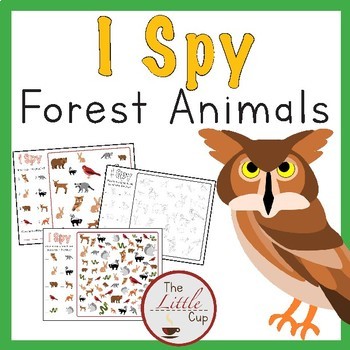- PDF
Description
I Spy is a great counting and brain break challenge game. This forest animal themed I Spy Game is fun for kids that love nature walks, animals, birds, and are learning to count.
I Spy game is perfect for preschool and kindergarten classrooms, road trips, traveling homeschoolers, and simple math for kids.
In this download you will find:
- 3 Color I Spy Boards in varying levels
- 3 Black and White I Spy Board Games in varying levels
I Spy is a great activity to target:
- numbers
- counting
- animal identification
- addition
We suggest printing on cards stock to help students use them year after year.
Thank you for taking the time to look at this product!
*************************************
Check out these related products:
Vehicle Road Trip Activity Pack
STEM Activities Pack: The Great Outdoors with Knots and Hitches
To see all of the products in my store click HERE.
Customer Tips:
How to get TPT credit to use on future purchases:
Please go to your My Purchases page (you may need to login). Beside each purchase you’ll see a Provide Feedback button. Simply click it and you will be taken to a page where you can give a quick rating and leave a short comment for the product. When you give feedback, TpT gives you feedback credits that you use to lower the cost of your future purchases. Well worth your time!
Be the first to know about my new discounts, freebies and new products:
Look for the green star next to my store logo and click it to become a follower. You will now receive email updates about my store.
Customer Service
If you have any questions, please feel free to email me or use the Ask aQuestion feature in TpT. I want to provide quality products to help teachers and students alike, so contact me before leaving feedback if you have a need. Please know that The Little Cup is apart of our parent company, First Cup To Close
The Little Cup Terms of Use
Products by The Little Cup may be used by the purchaser for their classroom use only. All rights reserved. No part of this publication may be reproduced, distributed, or transmitted without written permission of the author. This includes posting this product on the internet in any form, including classroom/personal websites or network drives. If you wish to share this product with your team or colleagues, you may purchase additional licensing at a discounted rate.
*****************************************************************
Be the first to know about my new and current resources and sales:
Click on the green star next to my logo at the top of the page. Now you'll be the first to know when there is a sale!
*****************************************************************
Please let me know if you have any questions before you make your purchase! Our goal is amazing customer service!
Marie & Sean Mack




